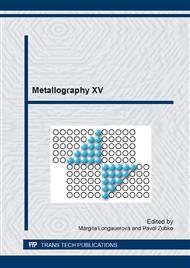p.23
p.31
p.41
p.45
p.51
p.57
p.61
p.67
p.73
Non-Traditional Use of Torsion Plastometer in Physical Simulation of Steel Production
Abstract:
The present paper provides a picture of metallographic and plastometric research in the border areas of steel production and forming. The focus of the paper is simulation conducted in SETARAM plastometer. The SETARAM plastometer used in the experiments has been modified recently. The changes concerned predominantly its temperature measurement and control devices. The lower limit of its operating temperatures was reduced to approximately 400 °C. The purpose of the most recent upgrade was to allow investigation in the region of steel brittleness related to loading in their freezing range. It will be possible to explore the behaviour of steels under the conditions of continuous casting processes, solidification in crystallizers and deformation during solidification. Microstructures of various types of steels are presented upon small continuous deformation applied at high temperature, which lead to partial melting and resolidification of test bars. Various types of sheet rolling simulations with reduced finish temperatures conducted in the plastometer are described. Approaches to evaluating continuous torsion tests to fracture in the field of basic research into materials plasticity are presented as well. In terms of interrupted tests, the importance of the anisotropic interrupted test as a source of information for research is touched upon. In particular, demonstration is given of the potential for finding transformation temperatures governed by deformation in the 1.0583 steel grade. A physical simulation procedure involving strain-induced ferritic transformation has been developed on the basis of results of tests. Mechanical properties were measured on specimens processed in the simulation. Microstructures resulting from the thermomechanical simulation are discussed.
Info:
Periodical:
Pages:
51-56
Citation:
Online since:
April 2014
Authors:
Price:
Сopyright:
© 2014 Trans Tech Publications Ltd. All Rights Reserved
Share:
Citation:


